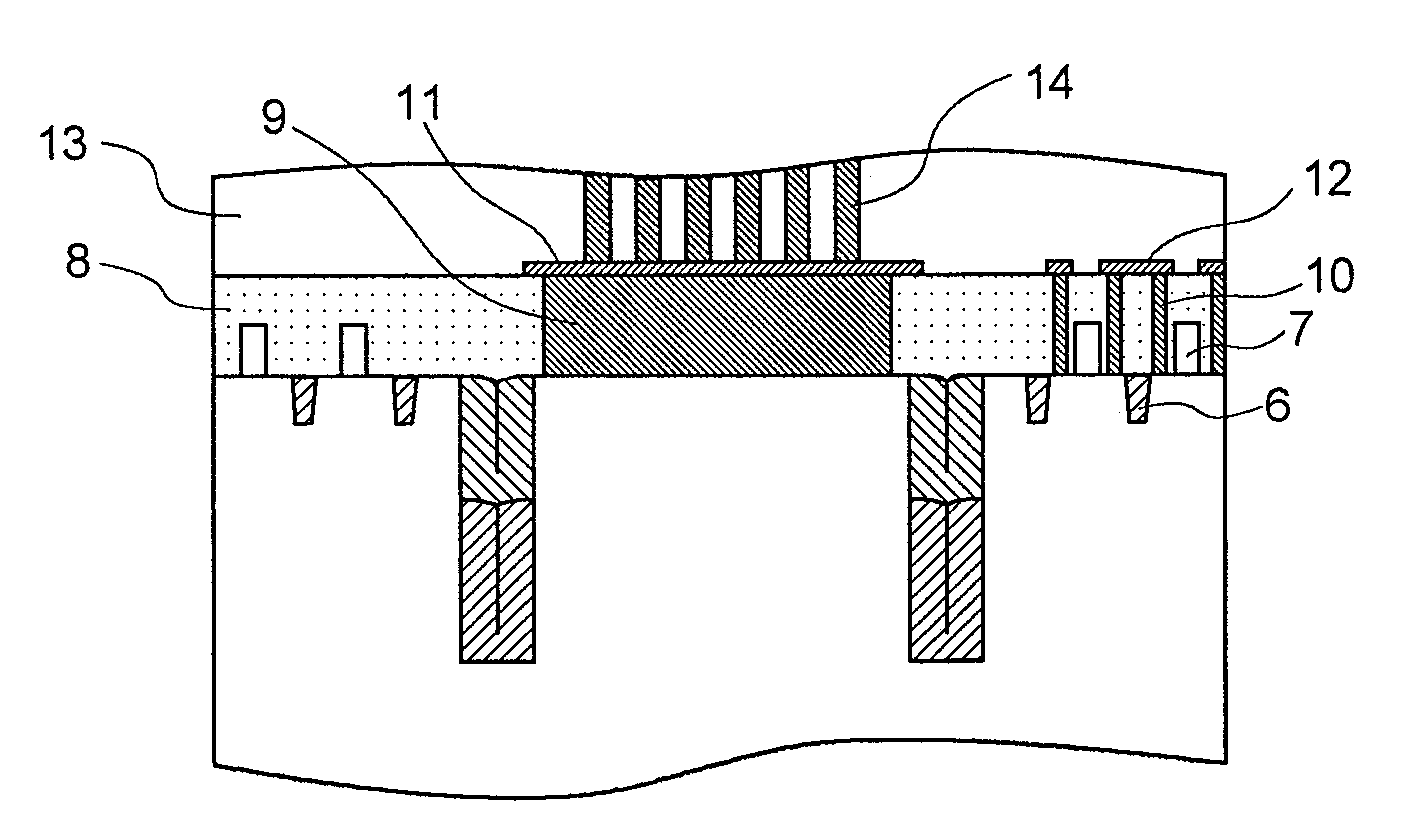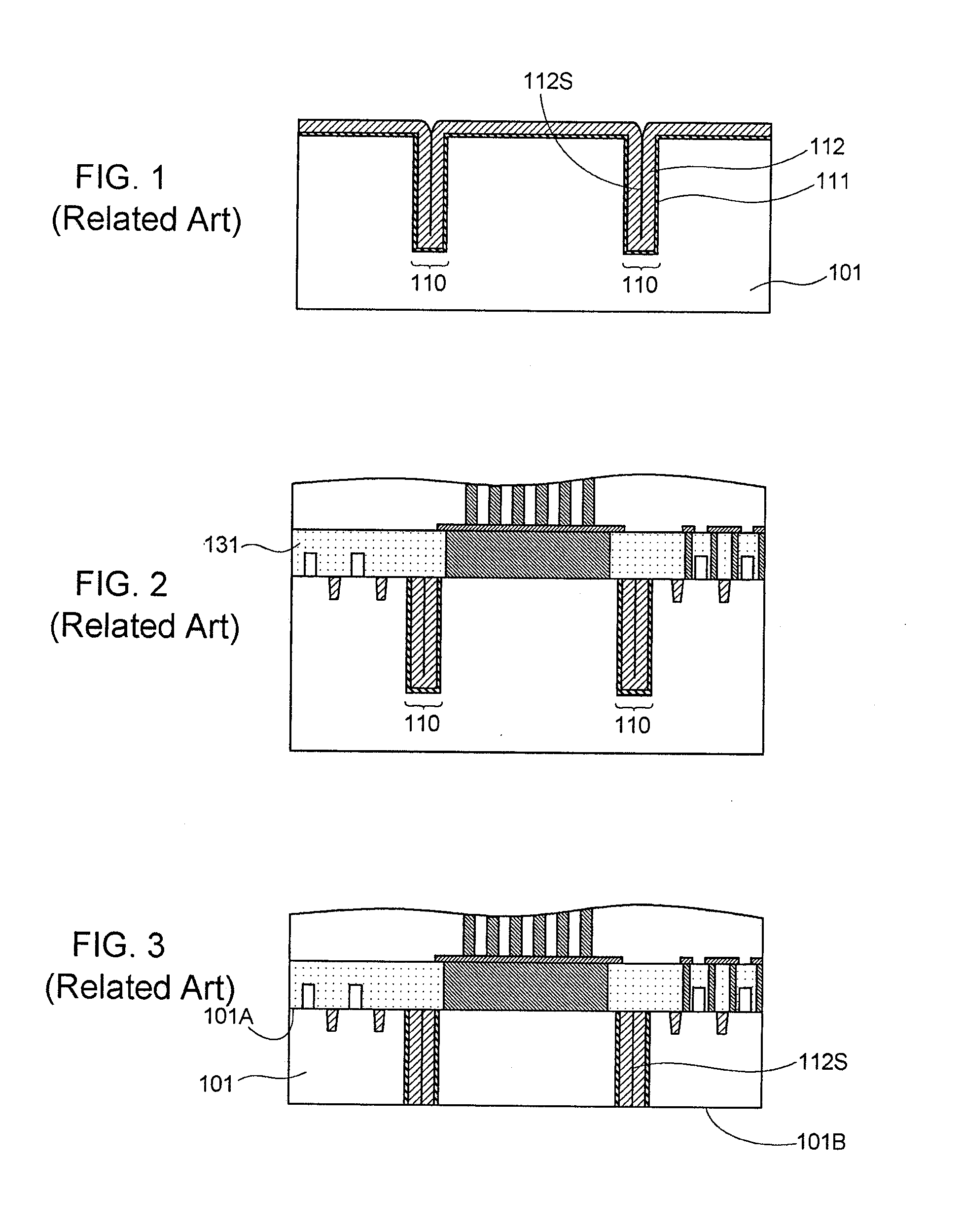Method of manufacturing semiconductor device
a manufacturing method and semiconductor technology, applied in semiconductor devices, semiconductor/solid-state device details, electrical devices, etc., can solve the problems of poor chemical resistance of insulating film formed in this method, damage to the chip, and danger of the destruction of semiconductor elements, so as to increase the mechanical strength and increase the yield of production
- Summary
- Abstract
- Description
- Claims
- Application Information
AI Technical Summary
Benefits of technology
Problems solved by technology
Method used
Image
Examples
first exemplary embodiment
[0036]First, as shown in FIG. 6, a ring-shaped trench (a circular ring-shaped trench) 2 having a depth 50 μm and a width 2 μm is formed in a main surface side (first surface side) of a semiconductor substrate (silicon substrate) 1 by dry etching. The processing of the trench 2 includes forming a silicon nitride film (not shown) as a mask on the silicon substrate 1, and then the ring-shaped opening is formed using photolithography technology. In subsequence, the main surface of the silicon substrate 1 is selectively removed by etching using the shaped silicon nitride film as the mask. After the silicon substrate 1 is etched, the shaped silicon nitride film is removed. Alternatively, a next first insulating film may be formed without removing the shaped silicon nitride film.
[0037]In subsequence, a first insulating film 3 is deposited on the main surface of the silicon substrate 1, including the inside of the trench. Here, as the first insulating film 3, a non-doped silicate glass (NSG...
modified examples
[0053]In subsequence, modified examples of the first exemplary embodiment will be described.
[0054]In the foregoing explanation, both the first insulating film 3 and the second insulating film 4 are formed by CVD, as the films that have the seam 3S and the seam 4S, respectively. However, the invention is not limited to this construction, but one of the first and second insulating films can be formed by first deposition method, in which a seam is formed in the central portion of the width of the trench except for the bottom at the startup of the CVD, and the other insulating layer can be formed by second deposition method, in which no seam is formed. FIG. 13A shows the multi-stage structure including a first insulating film 3-1, which is formed by the first deposition method, and a second insulating film 4-2, which is formed by the second deposition method. In contrast, FIG. 13B shows the multi-stage structure including a first insulating film 3-2, which is formed by the second deposi...
second exemplary embodiment
[0062]In the first exemplary embodiment, etching back is performed after the first insulating film is formed. However, in some cases, the etching back is not necessary when the first insulating film is made of a flowable insulating material. FIG. 17A to FIG. 17D are process cross-sectional views depicting a method of manufacturing a semiconductor device, which includes a deposition process using a flowable insulating material by flowable CVD.
[0063]First, as shown in FIG. 17A, ring-shaped trenches 32a and 32b are formed in a silicon substrate 31 in order to form insulating rings. In this exemplary embodiment, a case, in which double insulating rings, including a first insulating ring and a second insulating ring, are formed, is presented. When the double insulating rings are formed, each width of the trenches is smaller than that of the trench of a single insulating ring, but the aspect ratio is increased due to the decreased trench width. A trench having a large aspect ratio tends t...
PUM
 Login to View More
Login to View More Abstract
Description
Claims
Application Information
 Login to View More
Login to View More - R&D
- Intellectual Property
- Life Sciences
- Materials
- Tech Scout
- Unparalleled Data Quality
- Higher Quality Content
- 60% Fewer Hallucinations
Browse by: Latest US Patents, China's latest patents, Technical Efficacy Thesaurus, Application Domain, Technology Topic, Popular Technical Reports.
© 2025 PatSnap. All rights reserved.Legal|Privacy policy|Modern Slavery Act Transparency Statement|Sitemap|About US| Contact US: help@patsnap.com



